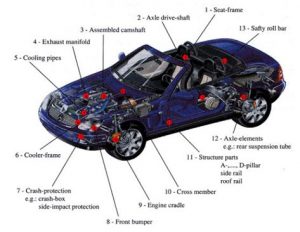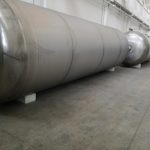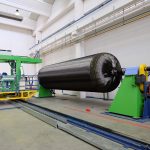The hydroforming is the first important milestone in technology perspective for GASVESSEL. Metals hydroforming is not new – but in at this huge scale has never done before that’s why the project is very important to us. Let’s take look at the automotive industry to have an overview of what has been done before with hydroforming.
One of the largest applications of hydroforming is the automotive industry, which makes use of the complex shapes made possible by hydroforming to produce stronger, lighter, and more rigid unibody structures for vehicles. This technique is particularly popular with the high-end sports car industry and is also frequently employed in the shaping of aluminium tubes for bicycle frames.
Since the 1990s, hydroforming has been revolutionizing specific aspects of various industries. Advances in hydroforming have affected our lives more than most of us even know. In a world without hydroforming, automobiles are heavier, weaker, less safe, more expensive, and significantly less fuel efficient. A world without hydroforming is also a world that is less green.
Recap of ADVANTAGES of HYDROFORMING
- Hydroforming draws material into the mold
- Part consolidation
- Weight reduction through more efficient section design and tailoring of the wall thickness
- Improved structural strength and stiffness
- Lower tooling cost due to fewer parts
- Fewer secondary operations (no welding of sections required, and holes may be punched during hydroforming)
- Tight dimensional tolerances and low spring back
- Reduced scrap
Results compared to conventional steel body structure:
- 50% less weight
- 45% less parts (less tools, less assembly)
- 45% less welding seams
- Tighter tolerances
Hydroforming in the Auto Industry
Back in 2002, Dodge began incorporating hydroforming to help reduce chassis vibration on its redesigned Dodge Ram. Likewise, General Motors suppliers began using hydroforming to create their suspension parts. There was an eventual increase of approximately 20 percent in manufacturing productivity for General Motors, and the switch to hydroforming may have contributed to the gain.
GM continues to use hydroforming in its production methods. In 2006, it became one of the first automakers to use the process to create full body panels on vehicles for several of its brands. Although sheet metal hydroforming is in limited use for exterior body panels (often for low-volume after-market parts), GM has employed it for producing exteriors for some of its vehicles.
Other examples of hydroforming in the automobile industry include the making of engine cradles for various Pontiac, Chevrolet, Ford, and Dodge brands. The process has also been used by several European automobile manufacturers, such as Volkswagen, which switched from deep drawing to hydroforming in order to create unibody frames for some of its vehicles.In 2002, Dodge began incorporating hydroforming to help reduce chassis vibration on its redesigned Dodge Ram. Likewise, GM suppliers began using hydroforming to create their suspension parts. There was an eventual increase of approximately 20 percent in manufacturing productivity for General Motors, and the switch to hydroforming may have contributed to the gain.
GM continues to use hydroforming in its production methods. In 2006, it became one of the first automakers to use the process to create full body panels on vehicles for several of its brands. Although sheet metal hydroforming is in limited use for exterior body panels (often for low-volume after-market parts), GM has employed it for producing exteriors for some of its vehicles.
Other examples of hydroforming in the automobile industry include the making of engine cradles for various Pontiac, Chevrolet, Ford, and Dodge brands. The process has also been used by several European automobile manufacturers, such as Volkswagen, which switched from deep drawing to hydroforming in order to create unibody frames for some of its vehicles.
In addition, a number of automotive companies have employed hydroforming to fabricate parts for instrument panel supports, radiator supports, frame rails and other components found in today’s cars.
In the GASVESSEL project, the hydroforming technology is used to shape the liner, the gas-impermeable inner core of the cylinder. The liner is inserted into the hydroforming mould and filled with water. A special hydraulic circuit puts it under pressure until sufficient pressure is reached to permanently deform it and the liner is pushed against the hydroforming mould walls. With this technique, the liner obtains the internal dimensions of the mould, in terms of geometric shape, thickness and mechanical characteristics. This process gives the best results if the base material is an austenitic stainless steel and in particular an AISI 304 or 301.



